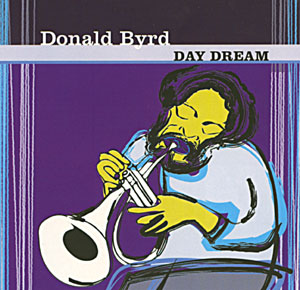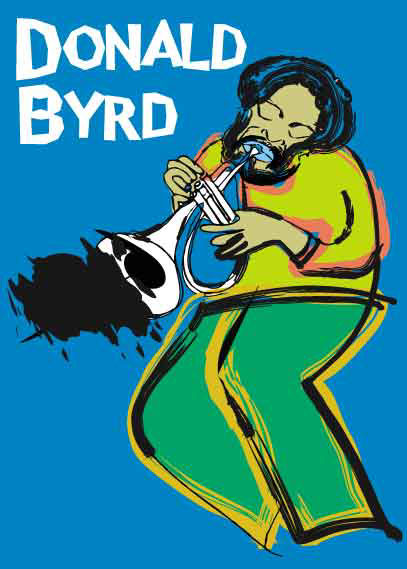|
Donald Byrd Biography Always educationg himself in music and he became an educator, the Donald Byrd Biography introduces you to the "teacher"! His father, a Methodist minister, was an amateur musician, and Byrd was already an accomplished trumpeter by the time he finished high school, having performed with Lionel Hampton. Byrd served a stint in the Air Force, during which time he played in a military band, and subsequently completed his bachelor's degree in music at Wayne State University in 1954. It seems quite a few of these jazz cats were in military bands and that gave the dudes chances to use instruments they may not have been able to afford! He moved to New York in 1955 to get his master's at the Manhattan School of Music, and soon began performing with pianist George Wallington's group. In December of that year, he was invited to join Art Blakey's Jazz Messengers, filling a chair once held by his idol, Clifford Brown, and Kenny Dorham. Byrd also began his recording career during this period, leading several sessions (mostly for Savoy) and working often as a sideman, particularly at the Prestige label. He left the Jazz Messengers in 1956 and joined up with Max Roach; he went on to play with the likes of John Coltrane, Sonny Rollins, and Red Garland, and also co-founded the Jazz Lab Quintet with altoist Gigi Gryce in 1957. In 1958, Byrd signed an exclusive recording contract with Blue Note, and also formed a band with baritonist Pepper Adams, who would remain Byrd's regular partner until 1961. Byrd's Blue Note debut was 1958's Off to the Races, and he and Adams collaborated on a series of excellent hard bop dates over the next three years, including Byrd in Hand (1959), At the Half Note Cafe, Vols. 1-2 (1960), The Cat Walk (1961), and Royal Flush (also 1961), among others. Another 1961 recording, Free Form, found Byrd giving a young Herbie Hancock some of his earliest exposure. You can tell a great jazz musician by the company he keeps! The cats who were the coolest and most innovative sought out the same dudes! Following this burst of activity, Byrd took a sabbatical to continue his studies in Europe, where he spent some time under the tutelage of the legendary French music educator Nadia Boulanger. He returned to the U.S. in 1963 and recorded A New Perspective, a now-classic set that broke new ground by incorporating gospel choirs into its arrangements; its signature piece, "Cristo Redentor," became quite popular. In the mid-'60s, Byrd focused more of his energies on teaching, and worked diligently to make jazz and its history a legitimate part of the college curriculum. He taught at Rutgers, Hampton, New York University, and Howard in the late '60s, and the last one remained a steady association for much of the '70s. In the meantime, Byrd continued to record occasionally, cutting a final spate of hard bop albums over 1966-1967 that included Mustang! and Blackjack. The cat was always trying to turn people on to the music of jazz and the younger generation dug his outlook and playing... Byrd also began to study African music, inspired partly by the emerging black-consciousness movement, and became interested in Miles Davis' efforts to woo a younger audience (including Byrd's own students) by experimenting with electronics and funk rhythms. 1969's Fancy Free found Byrd using electric piano for the first time, with a spacy sound that recalled Davis' In a Silent Way. 1970's Electric Byrd had more of a Bitches Brew flavor, and the jams on 1971's Ethiopian Knights were longer, funkier, and more aggressive. Byrd truly came into his own as a fusion artist when he hooked up with brothers Larry and Fonce Mizell, who began to handle production, writing, and some musical support duties. Their first collaboration was 1972's Black Byrd, an upbeat, funky blend of jazz and R&B. Jazz critics HATED the album and called Byrd all sorts of names, but the record was a smash hit; it became the biggest seller in Blue Note history, and just missed hitting number one on the R&B albums chart. Just because the cat got funky with jazz and got people to shake their tail, alot of "jazz-heads" thought Byrd had "sold out" the real jazz! In the wake of its success, Byrd formed a supporting group, the Blackbyrds, who were culled from the cream of his music students at Howard University and recorded through the rest of the '70s. Byrd went on to release a string of successful LPs in partnership with the Mizell Brothers, including the imaginary blaxploitation soundtrack Street Lady (1974), Stepping into Tomorrow (1975), the much-lauded Places and Spaces (1976), and Caricatures (1977). All made the Top Ten on the R&B album charts, and the Places and Spaces single "Change (Makes You Wanna Hustle)" even got substantial play in discotheques. Jazz-funk fans revere this period in general, but usually reserve their highest praise for Street Lady and, especially, Places and Spaces. As a side note to his musical career, Byrd finished law school in 1976, and went on to teach at North Carolina Central University. Following Caricatures, Byrd parted ways with Blue Note and the Mizell Brothers and moved to Elektra. He recorded several albums over 1978-1983, but even the most commercially successful, 1978's Thank You...for F.U.M.L. (Funking up My Life), didn't match the infectiousness of his Blue Note jazz-funk outings. In 1982, Byrd received his Ph.D. from Columbia Teachers College. He spent a few years in the mid-'80s away from recording, due in part to ill health, but continued to teach, moving on to North Texas State and Delaware State. In the late '80s and early '90s, Byrd returned to the hard bop of his early days on several sessions for the Landmark label. He participated in rapper Guru's Jazzmatazz project in 1993, and with the advent of the jazz-rap movement and England's acid jazz revival, his '70s albums became hugely popular sources for samples. Byrd was one of the first jazz musicians to work seriously with rappers and helped bridge the gap between the young hip hop cats and the jazz cats... acid jazz showed that they could share the same bed... you dig? Byrd continued his activities as a jazz educator. He is a real soldier of jazz! 
|



